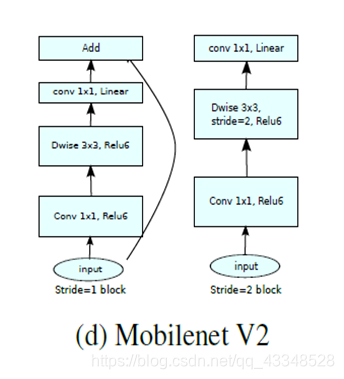- Mobilenet v2主体结构:



针对CIFAR10,没有考虑resize成224x224x3大小的input,还是保留其32x32x3的原始大小,因此相对应的调整了网络的结构,稍微有所缩减。
- 代码:
# Feel free to play with this cell
tf.reset_default_graph()
X = tf.placeholder(tf.float32, [None, 32, 32, 3])
y = tf.placeholder(tf.int64, [None])
is_training = tf.placeholder(tf.bool)
def mobilenet_v2_func_blocks(is_training):
def conv2d(inputs,filters,kernel_size,stride,scope=''):
with tf.variable_scope(scope):
with tf.variable_scope('conv2d'):
outputs = tf.layers.conv2d(inputs,filters,kernel_size,strides=(stride,stride),padding = 'same')
outputs = tf.layers.batch_normalization(outputs,training=is_training)
outputs = tf.nn.relu(outputs)
return outputs
def _1x1_con2d(inputs,filters,stride):
with tf.variable_scope('1x1_conv2d'):
outputs = tf.layers.conv2d(inputs,filters,[1,1],strides=(stride,stride),padding='same')
outputs = tf.layers.batch_normalization(outputs,training=is_training)
return outputs
def expansion_conv2d(inputs,expansion,stride):
input_shape = inputs.get_shape().as_list()
filters = input_shape[3] * expansion
kernel_size = [1,1]
with tf.variable_scope('expansion_1x1_conv2d'):
outputs = tf.layers.conv2d(inputs,filters,kernel_size,strides=(stride,stride),padding='same')
outputs = tf.layers.batch_normalization(outputs,training=is_training)
outputs = tf.nn.relu6(outputs)
return outputs
def projection_conv2d(inputs,filters,stride):
kernel_size = [1,1]
with tf.variable_scope('projection_1x1_conv2d'):
outputs = tf.layers.conv2d(inputs,filters,kernel_size,strides=(stride,stride),padding='same')
outputs = tf.layers.batch_normalization(outputs,training=is_training)
return outputs
def depthwise_conv2d(inputs,depthwise_filters,depthwise_conv_kernel_size,stride):
with tf.variable_scope('depthwise_conv2d'):
#outputs = tf.contrib.layers.separable_conv2d(inputs,None,depthwise_conv_kernel_size,stride=(stride,stride),padding='SAME')
outputs = tf.contrib.layers.separable_conv2d(inputs,depthwise_filters,depthwise_conv_kernel_size,stride=(stride,stride),padding='same')
outputs = tf.layers.batch_normalization(outputs,training=is_training)
outputs = tf.nn.relu(outputs)
return outputs
def avg_pool2d(inputs,scope=''):
input_shape = inputs.get_shape().as_list()
pool_height = input_shape[1]
pool_width = input_shape[2]
with tf.variable_scope(scope):
outputs = tf.layers.average_pooling2d(inputs,[pool_height,pool_width],strides=(1,1),padding='valid')
return outputs
def inverted_residual_block(inputs,filters,stride,expansion=6,scope=''):
depthwise_conv_kernel_size = [3,3]
pointwise_conv_filters = filters
with tf.variable_scope(scope):
net = inputs
net = expansion_conv2d(net,expansion,stride=1)
depthwise_filters = net.get_shape().as_list()[3]
net = depthwise_conv2d(net,depthwise_filters,depthwise_conv_kernel_size,stride = stride)
net = projection_conv2d(net,pointwise_conv_filters,stride=1)
if stride ==1:
if net.get_shape().as_list()[3]!=inputs.get_shape().as_list()[3]:
inputs = _1x1_con2d(inputs,net.get_shape().as_list()[3],stride = 1)
net = net + inputs
return net
else:
return net
func_blocks = {}
func_blocks['conv2d'] = conv2d
func_blocks['inverted_residual_block'] = inverted_residual_block
func_blocks['avg_pool2d'] = avg_pool2d
return func_blocks
def mobilenet_v2(inputs,y,is_training):
func_blocks = mobilenet_v2_func_blocks(is_training)
_conv2d = func_blocks['conv2d']
_inverted_residual_block = func_blocks['inverted_residual_block']
_avg_pool2d = func_blocks['avg_pool2d']
with tf.variable_scope('mobilenet_v2',[inputs]):
net = inputs
net = _conv2d(net,32,[3,3],stride=2,scope='block0_0')
print('!!debug block0,net shape is:{}'.format(net.get_shape()))
net = _inverted_residual_block(net,16,stride=1,expansion=1,scope='block1_0')
print('!!debug block1_0,net shape is:{}'.format(net.get_shape()))
net = _inverted_residual_block(net,24,stride=2,scope='block2_0')
net = _inverted_residual_block(net,24,stride=1,scope='block2_1')
print('!!debug block2,net shape is:{}'.format(net.get_shape()))
net = _inverted_residual_block(net,32,stride=2,scope='block3_0')
net = _inverted_residual_block(net,32,stride=1,scope='block3_1')
net = _inverted_residual_block(net,32,stride=1,scope='block3_2')
print('!!debug block3,net shape is:{}'.format(net.get_shape()))
net = _inverted_residual_block(net,64,stride=2,scope='block4_0')
net = _inverted_residual_block(net,64,stride=1,scope='block4_1')
net = _inverted_residual_block(net,64,stride=1,scope='block4_2')
net = _inverted_residual_block(net,64,stride=1,scope='block4_3')
print('!!debug block4,net shape is:{}'.format(net.get_shape()))
net = _inverted_residual_block(net,96,stride=1,scope='block5_0')
net = _inverted_residual_block(net,96,stride=1,scope='block5_1')
net = _inverted_residual_block(net,96,stride=1,scope='block5_2')
print('!!debug block5,net shape is:{}'.format(net.get_shape()))
net = _conv2d(net,160,[1,1],stride=1,scope='block6_0')
print('!!debug block6,net shape is:{}'.format(net.get_shape()))
net = _avg_pool2d(net,scope='block7')
flatten = tf.contrib.layers.flatten(net)
y_out = tf.layers.dense(flatten,10)
print('!!debug ,net shape is:{}'.format(y_out.get_shape()))
return y_out
print('my model')
y_out = mobilenet_v2(X,y,is_training)
print('come on')
mean_loss = None
optimizer = None
print('loss')
total_loss = tf.reduce_mean(tf.nn.softmax_cross_entropy_with_logits_v2(labels= tf.one_hot(y,10),logits=y_out))
#loss = tf.losses.sparse_softmax_cross_entropy( labels = y, logits = y_out)
mean_loss = tf.reduce_mean(total_loss)
optimizer = tf.train.RMSPropOptimizer(1e-3)
-
结果:
